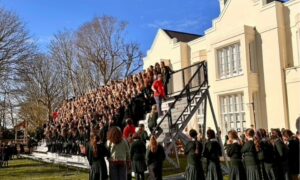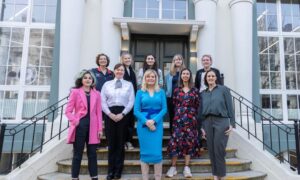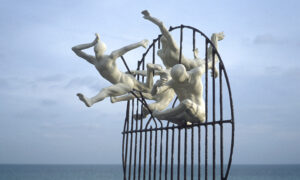“A delightfully appointed, compact property, nestled in the heart of the South Downs, with stunning woodland views and character features. Would suit first-time buyers looking for sustainable living close to the city. Two things to note: at night-time, the floor turns to lava, and look out for the fairy dust on entry – it’s there to guarantee sweet dreams and a good night’s sleep”.
Judging by the way the Brighton & Hove property market is going these days, it wouldn’t surprise me to find something similar in the windows of Lextons, but this is a paraphrase of a sales pitch delivered by Year 7 students during a trip to Parkwood Camp on Monday. When asked to construct shelters for Pre-Prep pupils, the Year 7s got to work with alacrity, and let their imaginations fly. Neighbouring plots included a dragon sanctuary, a “house of windows”, and a bijou cottage complete with a twig-lined driveway. There were some stunning interior design features: tree trunks festooned with flowers; a carpet of ferns, verdant and soft under foot; and rustic seating.
This trip marked the start of our second Wellbeing Week and, over the last few days, students throughout the school have had the opportunity to learn in different contexts. Meanwhile, behind the scenes, work has begun to construct next year’s timetable, a process of dividing and apportioning the curriculum into blocks, subject by subject, hour by hour.
It is easy to view school trips or off-timetable days as a welcome break from routine, a chance to relax and focus on the attributes many people refer to as “soft” skills, like collaboration or leadership. While these things are true, there is another kind of magic that emerges when students are released from routine in this way. As I witnessed at Parkwood Camp on Monday, it is on such days that we start to see the impact of the classroom-based learning, and how it may be utilised later. In addition to the teamwork on display, the impromptu sales pitches delivered by Year 7 students were superb, enough to make an off-duty English teacher proud. Judging by the awe-struck faces of the Pre-Prep pupils (property hunters for the afternoon), the Year 7s had thought carefully about their audience, persuasive language was plentiful, and the delivery spot on. This is all in addition to the problem-solving and design-thinking that had got them to the point of sale.
People often look to Finland as a model of progressive education and, sure enough, Finnish educationalists have gone a step further in their aim to “decompartmentalise” the curriculum. Acknowledging that life does not fall nearly into subjects, in 2026, Finland’s National Core Curriculum for Basic Education mandated the use of “phenomenon-based learning” (PhenoBL) and it has attracted growing attention ever since. In Finland, students aged 7-16 are required to participate multidisciplinary modules, designed to explore “real-world phenomena that can be viewed from competing and complementary viewpoints”.
As ever, the jury is still out on the effectiveness of phenomenon-based learning, and it could be argued that it is simply another name for what we do regularly, during weeks like the one we have just enjoyed.
So maybe this is the Brighton Girls version: take some entrepreneurial pixies, add a waft of sylvan splendour and a sprinkle of fairy dust – the results will be phenomenal!


